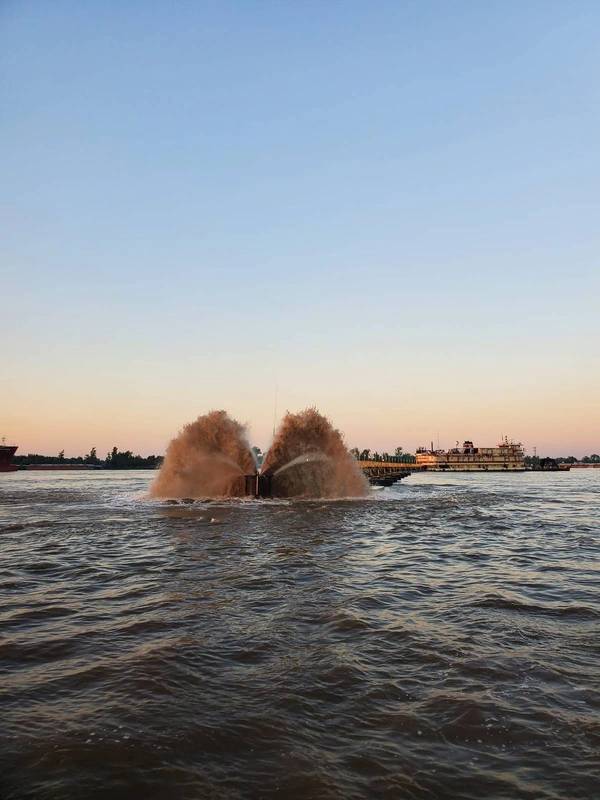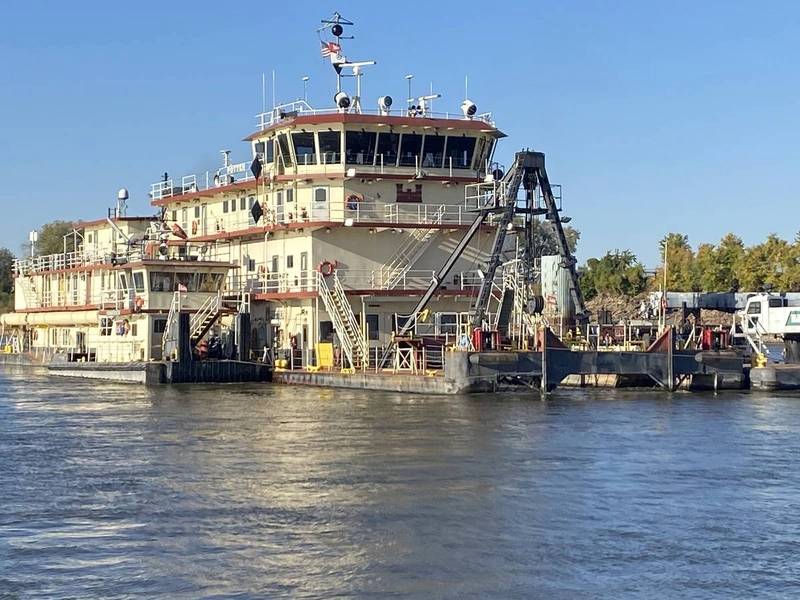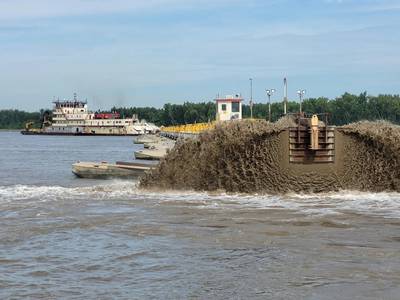Corps Dredges Log Record Seasons to Combat 2022 Drought Impact
Extreme weather events—including both high and low water levels—can wreak havoc on inland waterways transport. In late 2022, severe drought conditions brought the latter to the Mississippi River Basin, underlining the importance of America’s dredging fleet.
When the U.S. Army Corps of Engineers (USACE) Memphis District's dredge Hurley returned to its home port, Ensley Engineer Yard, in Memphis Harbor, on January 13, 2023, it wrapped its longest, most productive season on record. Over the course of 273 days, its 36-person crew dredged 14.5 million cubic yards of material, the most the dredge has ever removed in a single season (for comparison, it dredged just under 12 million cubic yards of sediment during the previous season).
Hurley, a 353-feet-long self-propelled dustpan dredge built in 1993, can dredge to a depth of 75 feet and discharges material outside the navigation channel through a 32-inch diameter pipeline. Dustpan dredges are unique to the Mississippi River and work to maintain a navigable channel for commercial navigation to move unimpeded. They play a critical role in helping to maintain the vital flow of maritime commerce on America’s inland river system, especially when water levels drop to historically low levels.
On October 17, 2022, the Mississippi River in Memphis, Tenn., measured at an all-time low of -10.76 feet. River levels impacted navigation in many ways, including an increased need for dredging in reaches of the river that haven’t needed it since the early 2000s. The Hurley, for example, dredged 28 locations this season, including 12 that were added due to low river levels at sites in the Corps’ Memphis, Vicksburg, St. Louis and New Orleans districts.
The furthest north the Hurley traveled to dredge was on the Upper Mississippi River Mile 113 at Cherokee Landing, 848 river miles north of the farthest south location dredged, at Sardine Point on the Lower Mississippi River Mile 219.
"The Hurley was called upon to assist where and as needed," Navigation Branch Chief Matt Young said.
With its record 2022-2023 season now in the books, Hurley is docked at the Ensley Engineer Yard stringout for routine maintenance and repairs in preparation for its next departure. Scheduled work includes repairing the ladder and ladder pump, dustpan, the three main generators, and Z Drives. Ensley Engineer Yard personnel perform much of this specialized work. "Even while repairs are performed, it's a regional asset and therefore important that the Hurley remain postured and ready to execute dredging operations, at a minimum within 72 hours, or at any given time should river conditions warrant it," Young said. "Many thanks to the Operations Division personnel who maintain and support the Dredge Hurley and crew. Their efforts ensure the Hurley crew can safely perform this vital mission, even in high demand times." |
Just down river from the Memphis District, the Vicksburg District’s 274-foot, 2,400-horsepower dredge Jadwin and its crew returned to the Vicksburg Harbor on January 19, after completing its own record-setting dredging season.
After departing May 10, 2022, the dustpan dredge spent 254 days on the water and relocated 6.2 million cubic yards of material from the Mississippi River. A normal dredging season lasts approximately 160 days.
First launched in 1933, Jadwin is a 274-foot, 2,400-horsepower dustpan type of dredge that is capable of dredging as deep as 68 feet. It typically performs dredging duties on the Mississippi River and its ports along the river from May to December.
Like Hurley, the 89-year-old Jadwin was also deployed to support additional USACE districts, including St. Paul, St. Louis, Memphis, New Orleans and Little Rock districts, as the Corps combatted low water events.
“Dredging is an essential mission to ensure safe and reliable navigation for our nation,” USACE Vicksburg District Commander Col. Christopher Klein said. “We’re incredibly appreciative of the Jadwin crew and their months of dedication and service through the most recent Mississippi River low water event. They answered the call and are heroes of the waterways.”
 The USACE Vicksburg District deployed its dredge Jadwin to help out several other districts. (Photo: USACE Vicksburg District)
The USACE Vicksburg District deployed its dredge Jadwin to help out several other districts. (Photo: USACE Vicksburg District)
Last year was also a record-setter for the USACE St. Louis District and its 1932-built dustpan dredge Potter, manned by a crew of 53, which completed its unprecedented season on February 1, 2023.
In a typical year for the district, some three to four million cubic yards of material will be moved by two dredges. During the 2022-2023 season, nine million cubic yards of material was moved by a total of nine dredging units deployed to battle the extreme low water conditions at 70 different locations along 300 miles of the St. Louis District.
It took a combination of expert thinking and proactive planning to get the job done. In anticipation of the drought, the St. Louis District dredging program manager, Lance Engle, brought in additional assets ahead of the forecasted lows to maintain the congressionally authorized channel as extreme low water conditions persisted.
Surveys were consistently performed and reviewed alongside forecasts and industry input to maximize dredging impact and efficiency in an ever-changing environment. Dredge crews were able to synchronize assets and coordinate efforts to prioritize and address dredging locations before they became an issue.
 The USACE St. Louis District’s dredge Potter also logged a record season to help maintain commercial river traffic. (Photo: USADE St. Louis District)
The USACE St. Louis District’s dredge Potter also logged a record season to help maintain commercial river traffic. (Photo: USADE St. Louis District)
“Without navigation on the Mississippi River, there would be significant impacts to our supply chain, economy, and national security," said Lou Dell’Orco, chief of operations and readiness.
According to Dell’Orco, “Advanced measures taken by the Dredging Product Deliver Team, dredges provided by sister districts, strategic management of low water conditions and the common operating picture that was maintained by the Corps, U.S. Coast Guard Sector Upper Mississippi River, the River Industry Action Committee and local partners resulted in maintaining the nine-foot shipping channel during extreme low water.”
“Above all, the master and crew of the dredge Potter excelled in the delivery of the dredging mission. Their passion and pride in operating and maintaining the 90-year-old vessel was critical to the success of the mission. The next steps in the process are to conduct off season maintenance on the dredge Potter and document lessons learned and best practices from this event to refine and improve future actions related to low water,” Dell’Orco said.

















